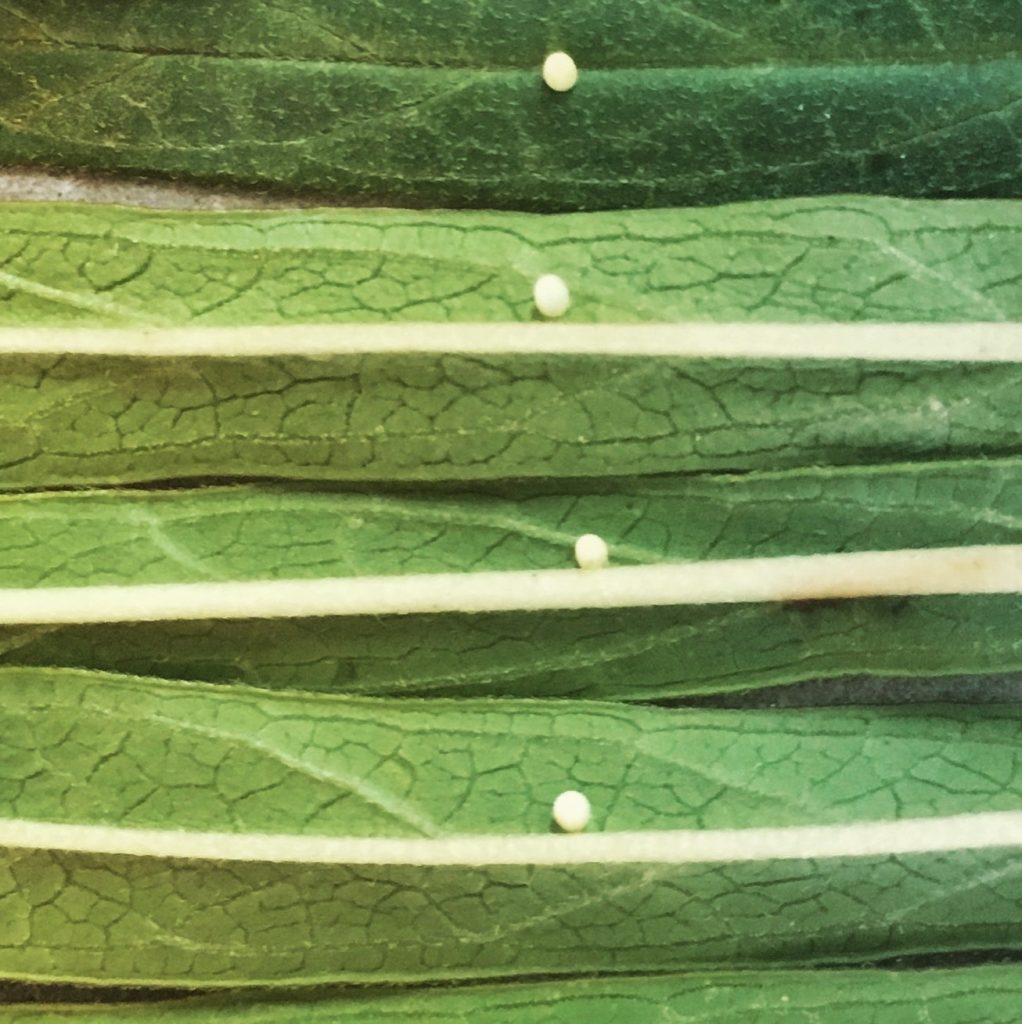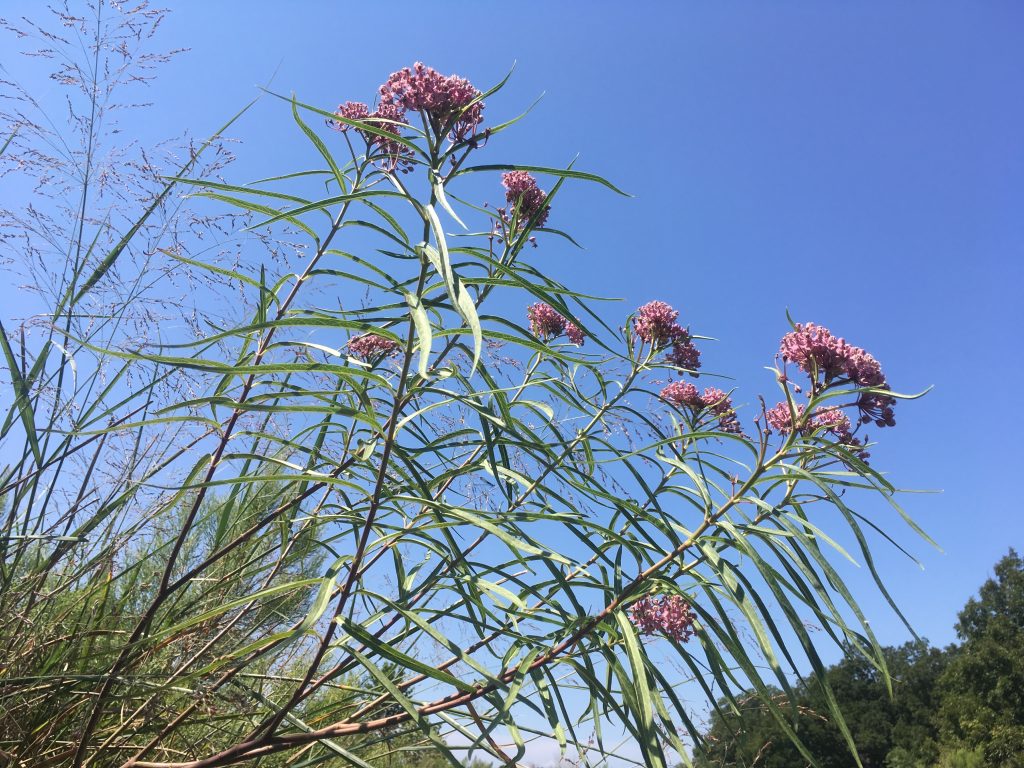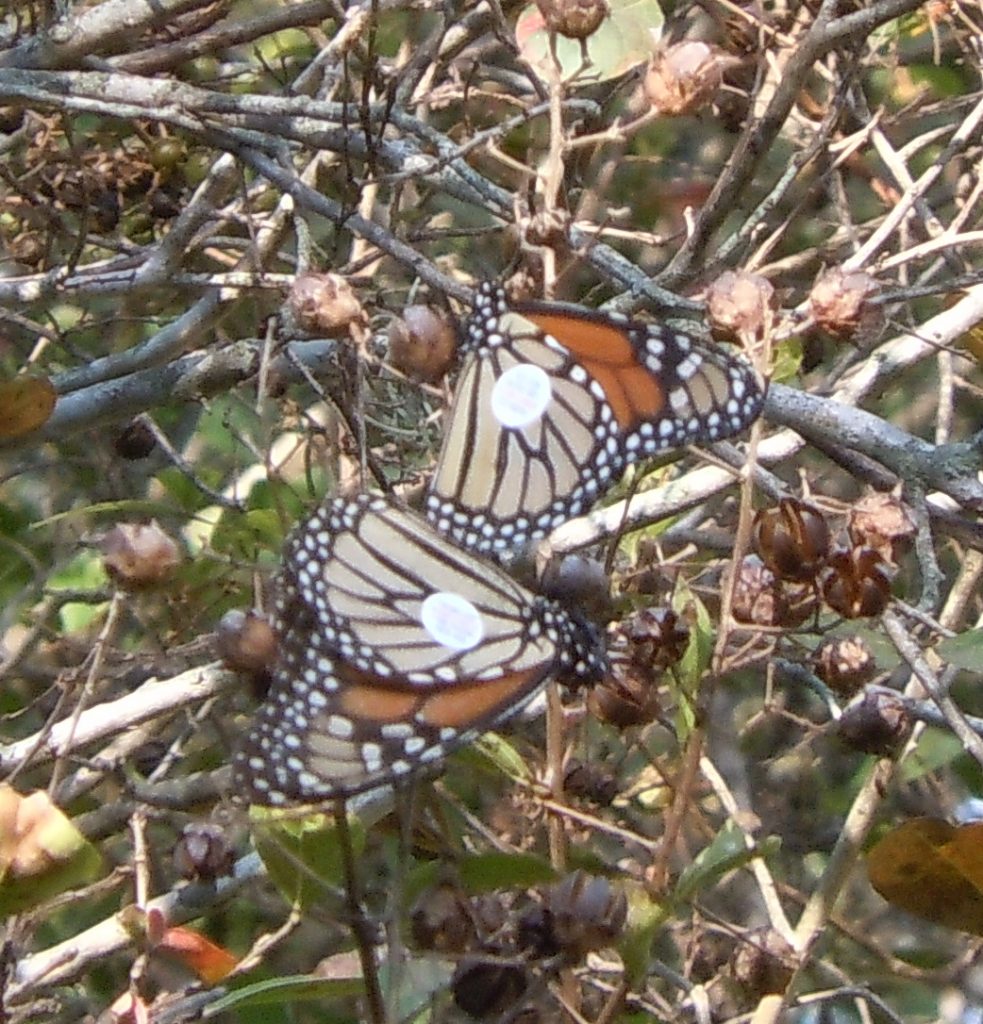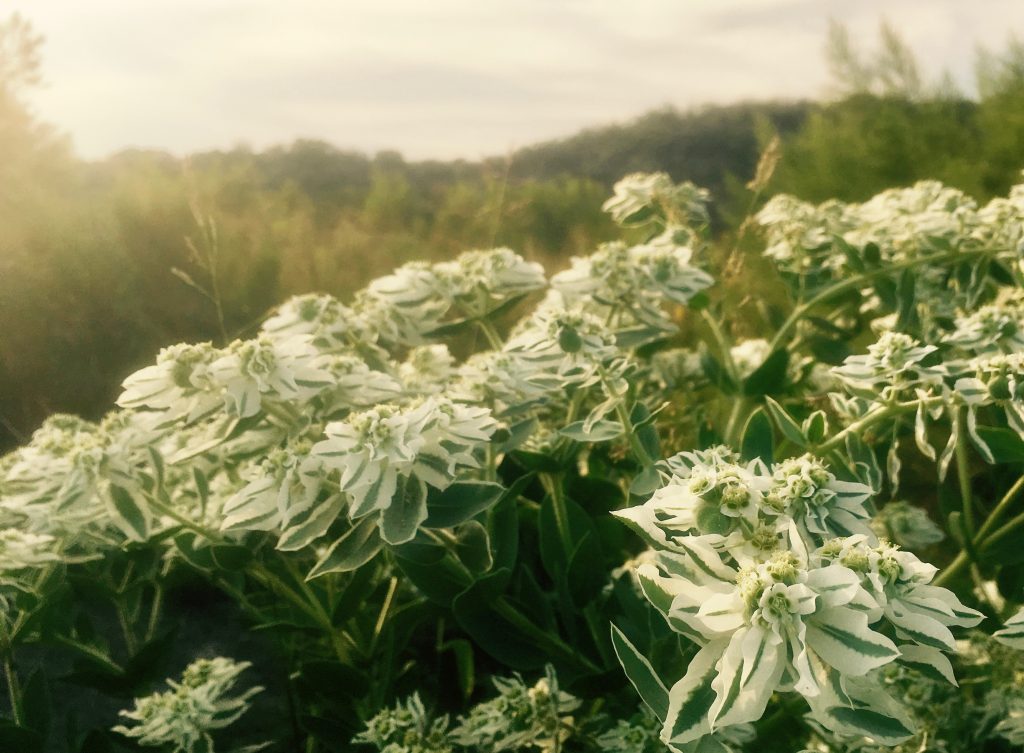Stands of flowering milkweed and late summer flowers await migrating Monarch butterflies in the Texas Hill Country this season. The iconic black and orange butterflies are projected to arrive here in about six weeks.

Got eggs? On the Llano River’s swamp milkweed, they’re everywhere. –Photo by Monika Maeckle
Every year around Labor Day, we get a small parade of Monarchs, what’s known as the “premigration migration.” This early pulse of butterflies, unlike later arrivals that suspend sexual activties to save their energy for the long trip to Mexico, are still reproductive and lay eggs on local milkweeds that hatch to become the final generation of migrating adults.
This weekend on the Llano River suggests an exceptional year. For the first time in 2017, I saw more Monarch butterflies than any other species, including Queens, which are regular visitors in September.

Swamp milkweed in full bloom greeted premigration Monarchs this weekend on the Llano. Photo by Monika Maeckle
About a dozen adult Monarch butterflies dipped between the Chigger Island sycamore trees, taking turns nectaring on the pink blooming stands of Swamp milkweed, Asclepias incarnata, before depositing eggs. Just before sunset on Sunday, two separate pairs of Monarchs passed our favorite pecan tree near the picnic spot locked in impressive courtship flights. In these stunning displays of stamina, the male firmly clasps the female with his pincers and lifts her into flight. The pair flies from bush to tree, locked in a butterfly embrace in a coupling that can last for hours.

Monarchs tagged on a Sunday in 2010, found mating on Monday. Photo by Monika Maeckle
In the file photo above, the butterflies pictured were tagged in my butterfly garden on Sunday, October 31, 2010. Shortly thereafter, they were observed mating. On November 1, they were spotted still locked in a reproductive dance–24 hours later.
All that coupling made eggs abundant this weekend. I noticed dozens while inspecting milkweed stands from my kayak, as did scientist David Berman of the Oklahoma State University. Berman stopped by to check in on the state of our milkweed habitat and count eggs, caterpillars and adults. He’s been monitoring two transects including dozens of milkweed plants along our stretch of river for about a year as a contractor on a study being conducted by Texas A & M University. In and around his 50-yard transect, Berman found 48 eggs and eight caterpillars in various stages, as well as several adult flyers. He arrived at our place from monitoring Monarchs in Abilene, where he said “Monarchs were everywhere.”

Egg at 11 o’clock about to hatch. See how the top is dark? Photo by Monika Maeckle
By my reckoning, if not taken by predators or disease, these eggs will hatch the first week in October, just in time to join the big pulse of Monarchs that typically move through the Texas Funnel during peak Monarch migration for our latitude. In San Antonio, 29 degrees, that happens October 10 – 22. Check your peak migration dates here.
Just a bit further south from us and close to the Llano’s headwaters, our sons Nicolas and Alexander Rivard kayaked the South Fork of the Llano River this weekend. They also reported dozens of Monarch sitings and a healthy river ecosystem poised for butterfly arrivals. Snow-on-the-mountain, goldenrod, water hemlock and late flowering boneset are putting on great shows right now.

Snow on the mountain occupies the Llano’s riverbanks. PHoto by Monika Maeckle
Our friends at Journey North, whose founder Elizabeth Howard will join us as a panelist on October 20 for our Butterflies without Borders Scientific Symposium in San Antonio, touted overnight roosts in Ontario as the migration takes flight from northern climes.
On the DPLEX list, the email list serve that includes about 800 Monarch butterfly scientists, citizen scientists and enthusiasts, reports are increasing in frequency and generally optimistic in tone.
On September 2, Matt Baumann of Iowa posted this report: “Adult numbers looking good here (Cedar Falls). Currently have over a dozen Monarchs at any given time in my yard feeding on meadow blazing star, zinnias, and Mexican sunflowers. More adult Monarchs than last year at this point in early Fall. Adults here now look very healthy and have their big ‘migration wings.”
The Facebook Group, Monarchs Migrating Through Ontario posted myriad reports of butterfly sitings and tagging. Rosetta McClain Gardens in east Toronto, Canada shared this: “… Aug 29th we tagged 66 monarchs. Slow but steady! Today the Monarchs came early and just kept coming all day until about 3PM. 102 tagged today! A great day of tagging. More females are starting to show up! YTD 612 monarchs tagged!”
Dr. Chip Taylor of Monarch Watch, who will also join our Butterflies without Borders Symposium as a panelist, predicted a healthy turn in his most recent Monarch Butterfly Population status report. “In sum, this looks to be a good year for monarchs – with a stronger migration in most regions and a good prospect that the overwintering population will increase from the 2.91 hectares of last year to 4 hectares or better this coming winter,” Taylor wrote in July.
All signs suggest he’s right.
- Monarch butterflies head north as Mexican scientists try to move their forest
- Butterflies without Borders: Monarch Butterfly and Pollinator Festival sete for October
- Monarch butterfly migrating population drops 27%, freak sleet storm to blame
- Monarch migration update: south winds, hot temps stall butterflies on Llano River
- Can’t get outside? Here’s how to track the Monarch migration from your desk
- San Antonio named first Monarch Butterfly Champion city by National Wildlife Federation
- Texas Comptroller awards $500K in Monarch research grants
- Butterfly bonanza: Monarch netted on Llano River tagged in Oklahoma
- How to Tag a Monarch Butterfly in Six Easy Steps
- What does climate change mean for Monarch butterflies?
- New study: late season nectar plantsmore important than milkweed to Monarch migration
Like what you’re reading? Follow butterfly and native plant news at the Texas Butterfly Ranch. Sign up for email delivery in the righthand navigation bar of this page, like us on Facebook, or follow us on Twitter, @monikam.


My first monarch of the year (2017) arrived August 22. I now have plenty of eggs on my tropical milkweed laid by at least 2 girls. I have also seen a male patrolling the milkweed. I have found 2 eggs on a small butterfly weed, but the tropical milkweed is the favorite. I live in Georgetown County (a coastal county), SC. I live inland in the northern part of the county. I’ve always wondered if our monarchs will migrate to Florida instead of Mexico.
The late summer migration this year has actually been relatively weak from Wisconsin westward to the Rocky Mountains. As of Sept. 5, only mere 10’s to low 100’s of butteflies have been reported clustering in that key region on Journey North. Thus I anticipate only a relatively modest sized migration will pass through western and central Texas this October.
At Star Island (Isles of Shoals, off Portsmouth NH) I saw 3 monarchs 3rd week of Aug, after several years of seeing one or none. One was in raggedy condition but still vital, still feeding; 2 looked newly-minted.
Many thanks to all you watchers and taggers for your work and care. May it be a good migration and winter.
Hello there:
My name is Janice Parker. We live in Amarillo and for years have wanted to watch the migration of butterflies. It says central Texas around whitchita falls, the end of September… We would live to go. Just trying to figure out where exactly. We r going to bring grandchildren to see this also. Any help is much appreciated.
Thank you
I seen one today in Central Texas , it won’t be long now , usually in September .
Monarch migration